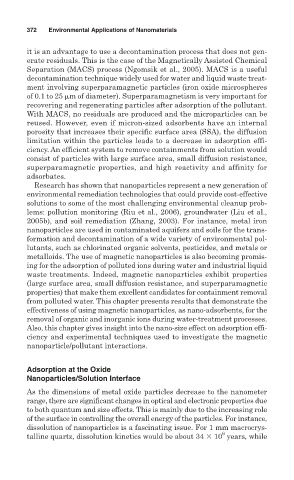Page 387 - Environmental Nanotechnology Applications and Impacts of Nanomaterials
P. 387
372 Environmental Applications of Nanomaterials
it is an advantage to use a decontamination process that does not gen-
erate residuals. This is the case of the Magnetically Assisted Chemical
Separation (MACS) process (Ngomsik et al., 2005). MACS is a useful
decontamination technique widely used for water and liquid waste treat-
ment involving superparamagnetic particles (iron oxide microspheres
of 0.1 to 25 m of diameter). Superparamagnetism is very important for
recovering and regenerating particles after adsorption of the pollutant.
With MACS, no residuals are produced and the microparticles can be
reused. However, even if micron-sized adsorbents have an internal
porosity that increases their specific surface area (SSA), the diffusion
limitation within the particles leads to a decrease in adsorption effi-
ciency. An efficient system to remove containments from solution would
consist of particles with large surface area, small diffusion resistance,
superparamagnetic properties, and high reactivity and affinity for
adsorbates.
Research has shown that nanoparticles represent a new generation of
environmental remediation technologies that could provide cost-effective
solutions to some of the most challenging environmental cleanup prob-
lems: pollution monitoring (Riu et al., 2006), groundwater (Liu et al.,
2005b), and soil remediation (Zhang, 2003). For instance, metal iron
nanoparticles are used in contaminated aquifers and soils for the trans-
formation and decontamination of a wide variety of environmental pol-
lutants, such as chlorinated organic solvents, pesticides, and metals or
metalloids. The use of magnetic nanoparticles is also becoming promis-
ing for the adsorption of polluted ions during water and industrial liquid
waste treatments. Indeed, magnetic nanoparticles exhibit properties
(large surface area, small diffusion resistance, and superparamagnetic
properties) that make them excellent candidates for containment removal
from polluted water. This chapter presents results that demonstrate the
effectiveness of using magnetic nanoparticles, as nano-adsorbents, for the
removal of organic and inorganic ions during water-treatment processes.
Also, this chapter gives insight into the nano-size effect on adsorption effi-
ciency and experimental techniques used to investigate the magnetic
nanoparticle/pollutant interactions.
Adsorption at the Oxide
Nanoparticles/Solution Interface
As the dimensions of metal oxide particles decrease to the nanometer
range, there are significant changes in optical and electronic properties due
to both quantum and size effects. This is mainly due to the increasing role
of the surface in controlling the overall energy of the particles. For instance,
dissolution of nanoparticles is a fascinating issue. For 1 mm macrocrys-
6
talline quartz, dissolution kinetics would be about 34
10 years, while

